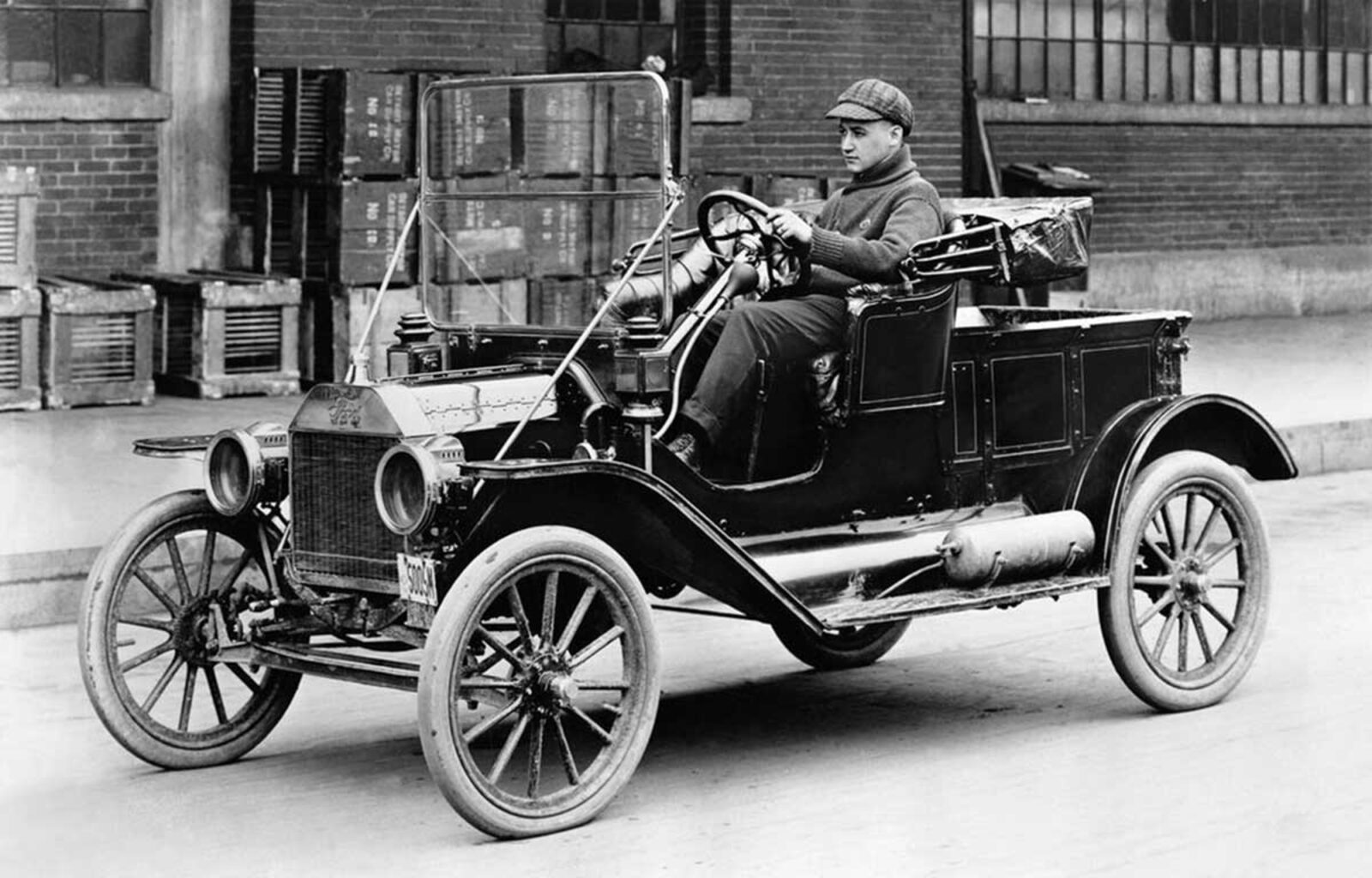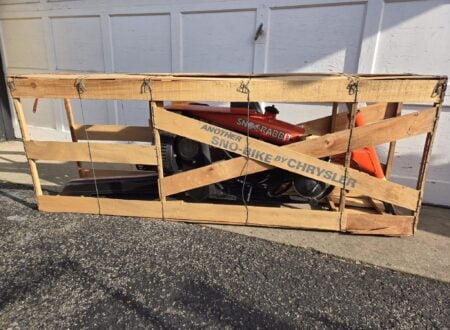The Beginnings of Ford Motor Company
Henry Ford’s Model T was the visionary breakthrough that brought motor vehicle ownership to millions of ordinary middle class people and opened up a new era of mobility for people and goods. In an era when the horse and the railroad reigned supreme as the means of land transport the Model T had to overcome a host of obstacles in order to obtain the success it enjoyed.
The turn of the nineteenth to the twentieth centuries was an era when roads were mostly dirt tracks traversed by horses pulling carts, wagons, stage-coaches, and the occasional “Surrey with a fringe on the top”. Automobiles had been around for a couple of decades or so but were rare, expensive, and a lot more temperamental than the average horse.
The technological expertise for maintaining a vehicle powered by an internal combustion engine was not widespread: and supply of fuel and oil was not so widespread either. When we think about the environment Henry Ford decided to market his automobiles in we can see that he took an enormous risk. The gamble paid off and the Model T would prove to be successful far beyond what most, including Henry Ford, could have hoped for or expected.
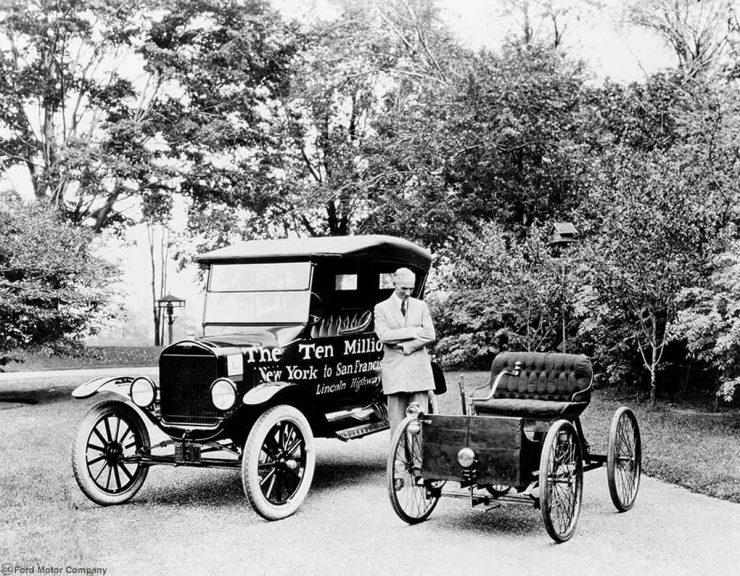
Above image courtesy of the Ford Motor Company.
Henry Ford had been working on the design of automobiles prior to the design of the Model T, his first known design being his Quadricycle of 1896. In 1899 he left the job he had at Edison and was briefly involved in the Detroit Automobile Company but left when it ceased operations in 1900. Ford went on during the period up to 1902 to form a company which was called the Henry Ford Company, but from which he resigned, and managed to do that while keeping his naming rights. That company subsequently reformed and became Cadillac.
Henry Ford worked on a number of automobile designs, ultimately producing an 80hp racing car which he built in collaboration with a cycle racer named Tom Cooper. This car was raced by Barney Oldfield in 1902, a race he won. Barney christened the car “999” after the famous New York Central and Hudson River Railroad locomotive of the time: a locomotive that was claimed to be able to do 100mph and which headed up the prestigious “Empire State Express” that ran between New York City and Buffalo.
This brought Ford some welcome publicity and an old friend named Alexander Y. Malcomson, who was in the coal business, arranged with Ford to create a business they called Ford & Malcomson, Ltd. with the intention of manufacturing automobiles.
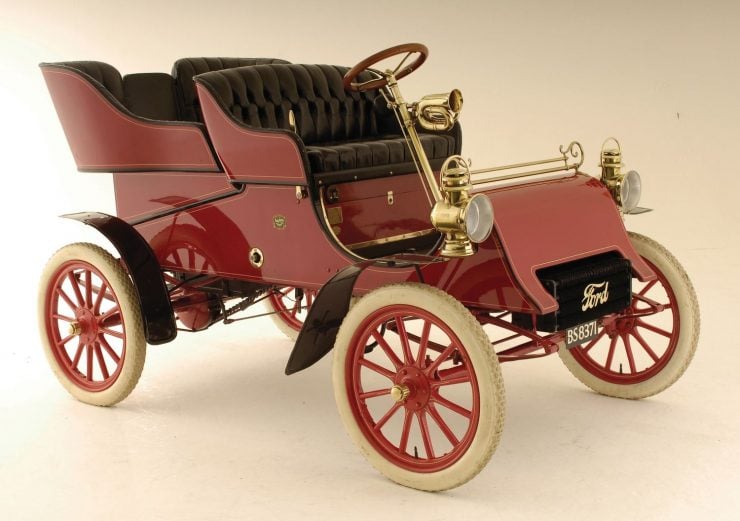
The new company contracted with a machine shop owned by John and Horace E. Dodge for supply of parts for the Ford & Malcomson automobiles. Unfortunately sales were too slow to maintain a sufficient cash flow to enable them to be financially viable.
This led to a number of other investors becoming involved including the Dodge brothers, and the company being reformed as the Ford Motor Company on June 16th, 1903.
The Ford Motor Company’s first car was the Model A of 1903. Ford Motor Company had been born and work began on the creation of an automobile that ordinary people would be able to afford, that would be reliable and capable of dealing with the dirt roads and harsh conditions that it would face in rural America.
Ford Model T – Design
Henry Ford called his first model the Model A ( a name he would later resurrect for the model that followed the Model T), and then he worked his way through the alphabet until he got to the Model T design. By the time he got to the Model T he had assembled a design team that included Childe Harold Wills, Joseph A. Galamb, Eugene Farkas, Henry Love, C. J. Smith, Gus Degner and Peter E. Martin. So Henry Ford was no longer working on the project by himself. The design team worked on prototypes until by 1908 they had a viable production model.
Henry Ford and his engineering team were aware of the pitfalls that caused automobiles of that era to be unreliable and they worked to eliminate as many potential sources of failure as possible. The engine was a simple 20hp gasoline four cylinder of 177 cu. in. (2.9 liter) capacity, mounted at the front of the vehicle. That engine was made to be able to burn gasoline (petrol), kerosene, or ethanol and was made to be easy to repair. It featured a detachable cylinder head and water cooling. The first 2,447 engines used a mechanical water pump to circulate cooling water: after that a more simple thermosiphon system was used. The engine was made so it could use fuels in common use in rural areas.
Kerosene was a common fuel for farm tractors and stationary engines, ethanol was a home grown alcohol which was moderately popular until it became unavailable with the advent of the Prohibition era in 1919. So Prohibition didn’t just prevent human beings from drinking alcohol, it stopped Fords from drinking it too. The Model T’s fuel tank held 10 US gallons of fuel and was located under the front seat.
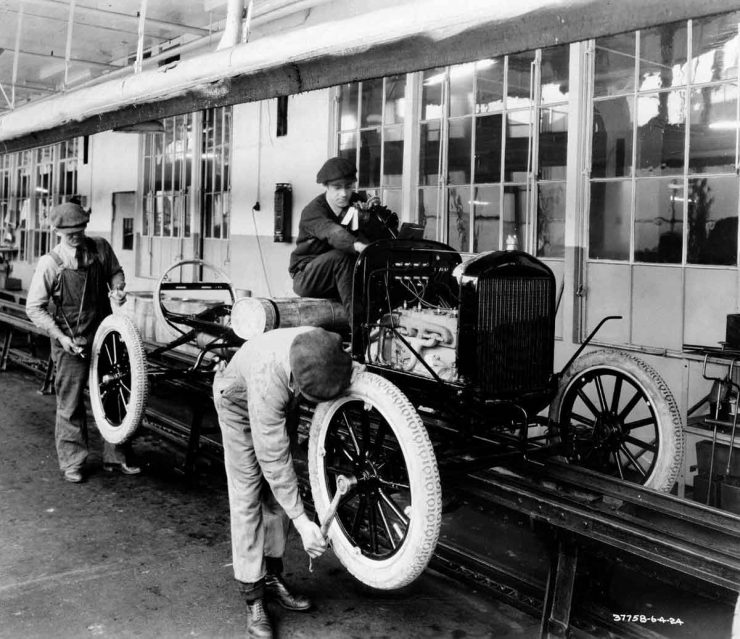
Fuel was fed to the engine by gravity and as a result owners found that the car could experience fuel starvation if they were driving up a really steep incline. The solution to that problem was to go up a steep incline in reverse, which was also better in that the reverse gear was the lowest. The downside of that was wheel slip on loose or slippery surfaces.
Ford’s engineers were well aware of the need to protect the potentially delicate ignition system from water and so they decided to use a low voltage magneto mounted on the flywheel and thus covered by the flywheel housing. This magneto supplied current to trembler coils (vibrator coils) to provide the necessary electrical voltage to the spark plugs. This was a system common to stationary engines and so was more likely to be familiar to mechanics in rural America. Starting the engine was done by winding the crank handle at the front of the car. With its low compression ratio the engine was made to be relatively easy to crank and the low voltage magneto provided adequate spark at low revolutions.
Back in 1908 there were not a lot of people who were familiar with driving a car. These were the days before synchromesh had been invented and so a straight cut sliding gear system was sometimes used, but such a “crash” gearbox is difficult to learn to use well. Ford’s engineers understood this and chose instead to use an epicyclic gearbox (planetary gearbox) with drive bands which would eliminate that difficulty in gear changing. The transmission used a wet clutch and provided two forward gears and a reverse gear, although it was advertised as being a “three speed” transmission.
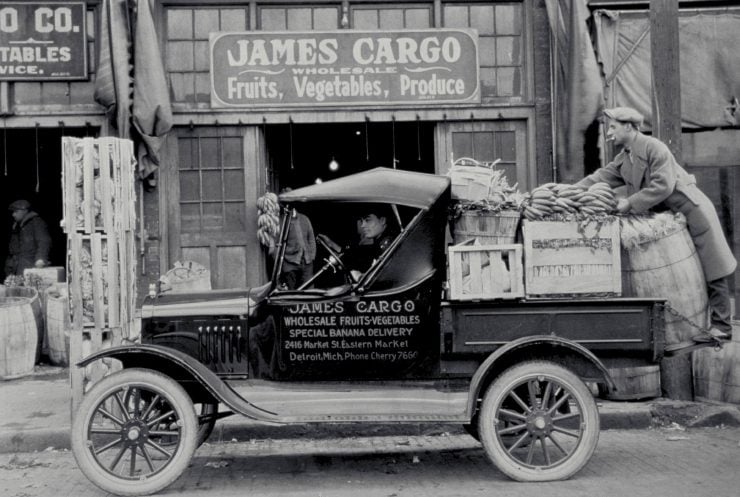
Driving the Model T was very different to the controls we are used to nowadays. The vast majority of people who would buy a Model T would have no experience in driving a motor car at all: so the controls were designed with that in mind. The accelerator/throttle was a lever on the steering wheel and there was also a control to advance/retard the ignition spark. On the floor were three pedals; the right side pedal for the brake, the center for changing between reverse and forward gears, and the left hand pedal used in conjunction with a gear lever was the clutch and used for changing between low gear, neutral, and high gear.
The gearbox sent its power to the rear wheels via a torque tube. The torque tube provides an external tube around a thin drive shaft and it served the purpose of locating the rear axle properly. This was made necessary because the Model T used transverse leaf springs which did not provide forward/backward support: so the torque tube provided that function. The logic in using transverse leaf springs was to enable more wheel travel and thus enable the Model T to negotiate rough tracks competently.
The Model T was not provided with brakes on the wheels but only on the transmission. Late production models were eventually provided with rear wheel brakes as an option. Initially after-market rear wheel brakes became available from third party manufacturers, and this ultimately pressured Ford into providing them. The transmission brake was operated by the right hand foot pedal, and there was a handbrake lever on the car’s floor also. The car could get up to speeds of about 40-45 mph (65-70 km/h) and with its rather minimalist braking system it appears it was made to go, not to stop.
The lights of the original Model T were not electric. The common lamps used on horse drawn vehicles were the lamps used on the Model T, this meant it used acetylene carbide headlights and oil side lamps. Electric lighting and electric starting became available for the Model T late in production during the 1920’s.
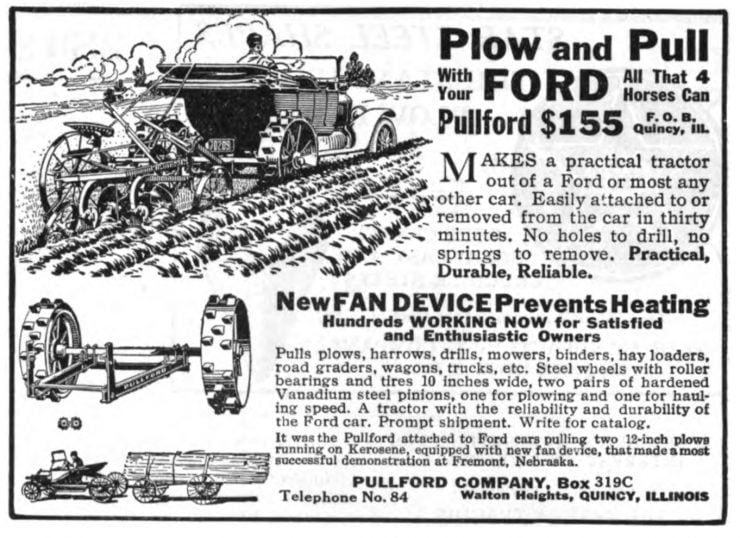
The Model T was made to be very useful in agricultural settings. It could be used as a stationary power source by removing one of its driving wheels and using a belt and pulley to power an electric generator, threshing machine, saw, conveyor belt or water pump for example. It was very much a predecessor of the utilitarian Land Rover and Jeep.
During its production life the Model T was adapted to all sorts of uses including being made into a rail car. Many after-market manufacturers offered ways to accessorize and adapt your Model T to your particular needs. There were even half-track conversions to enable a Model T to traverse snow.
Mass Production Of The Model T Ford
The Model T entered small scale production in the fall/autumn of 1908. When first introduced the Model T was made using much the same methodology as the other cars of that era. It was made by hand piece by piece. In the first month just eleven cars were constructed. These early hand built cars were available in a variety of colors and this would remain true through until 1912.
The Model T was also made in a range of body styles; the six seat town cars were painted gray, five seat touring cars were in red, and green was available for touring cars, town cars, two seat coupes/runabouts, and Landaulets. All models were built on the same chassis with a wheelbase of 100″. By 1912 all Model Ts were painted in midnight blue with black fenders, and in 1914 Henry Ford decided that customers could have any color they liked as long as it was black, and so the cars produced after that time were black.
Paint technology was a developing science and the black paint is said to have been faster drying and therefore more convenient to use in the Ford production line environment at that time. We should also remember that the price of the Model T was constantly going down as mass production became more efficient.
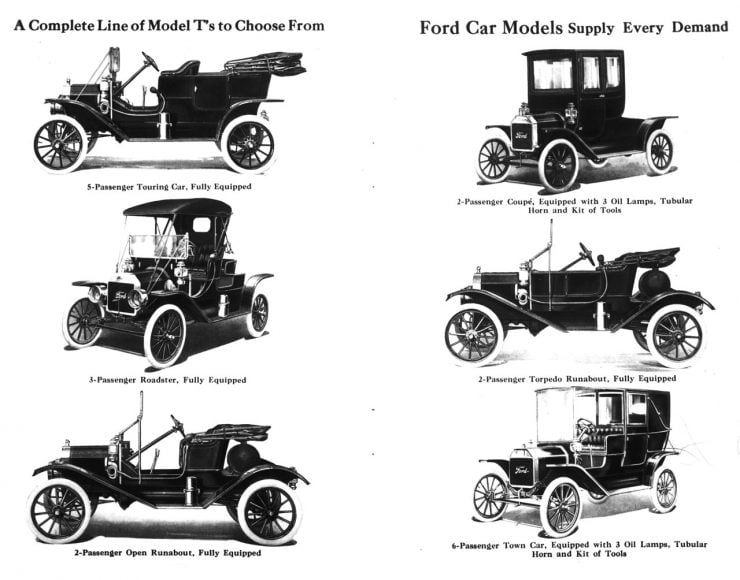
By 1910 12,000 Model T cars had been produced but Ford were straining to keep up with demand. New methods of building the cars were needed and so Ford moved to a new production facility, the Highland Park Complex. For this new facility a production team comprising Childe Harold Wills, Clarence Avery, Peter E. Martin, and Charles E. Sorensen set about creating a production line that would dramatically increase output.
Henry Ford and his team understood the principle of “Practice makes perfect” and thus that if a worker had a simple set of tasks to perform then they would become very practiced and expert at what they did. So Ford and his team analyzed the process of building a Model T and broke it down so that each worker had a limited range of skills to learn and apply, and thus could become very practiced at their job.
With these new production line methods the build time for a Model T was reduced from 12.5 hours to 93 minutes by 1914. The price of the Model T was also rapidly coming down from its original hand built cost of $825 in 1908 down to a mass produced cost of $360 by 1916.
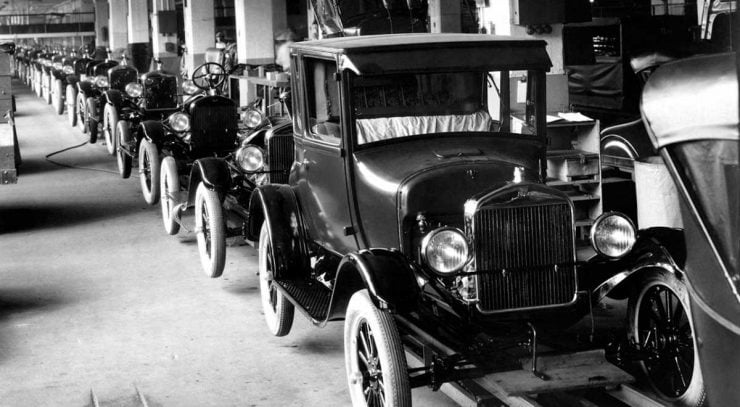
The Model T Ford Goes To War
Henry Ford was a staunch pacifist and was not at all inclined to see his Model T used during the First World War, despite its then being known as “The War To End All Wars”. Henry Ford would not involve himself or his company in building specialized versions of the Model T for military use, but he was willing to sell Model T rolling chassis and spare parts to the military and ambulance services of nations involved in the conflict for them to convert however they wished.
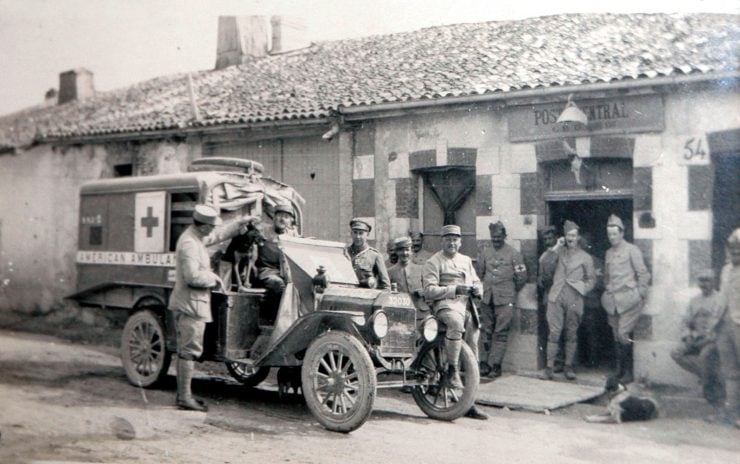
Perhaps the best known conversion for service in WW1 was as an ambulance. Some of these ambulances were driven by people who would become famous in the United States after the war including Walt Disney and Ernest Hemmingway. A Model T ambulance could go places many other vehicles could not and if it did get stuck a group of soldiers would normally be able to lift and bounce it enough to get it unstuck. A typical Model T tipped the scales at around 1,300 lbs so it was not a heavy vehicle.
There were quite a number of innovative conversions of the Model T made for military service. All of them are interesting and the Polish use of a Model T to create an early armored car is one. The Poles designated their armored car the Ford FT-B. This Model T conversion was created in two weeks and served the Polish Army well in their battles with the Russian Bolsheviks.
Before the war the Model T had been available with many after-market conversions, including a half-track conversion. For use in the Great War there was even a full-track version created and trialed.
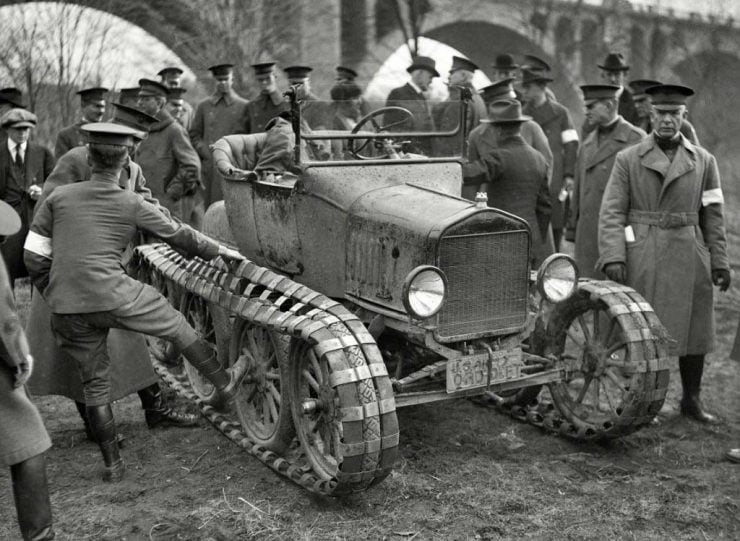
At the outbreak of the Great War in 1914 Model T Fords were a part of the action. These Model T’s were purchased by allied and associated organizations from Ford dealerships in Britain and France with the first American Field Service ambulances appearing at the front working to transport French wounded in 1915.
The French Army fielded about 11,000 Model T’s for the war effort. British and Empire Forces fielded somewhere between 20,000 to 30,000 and the Tin Lizzy’s were used in Europe, Africa and the Middle East campaigns.
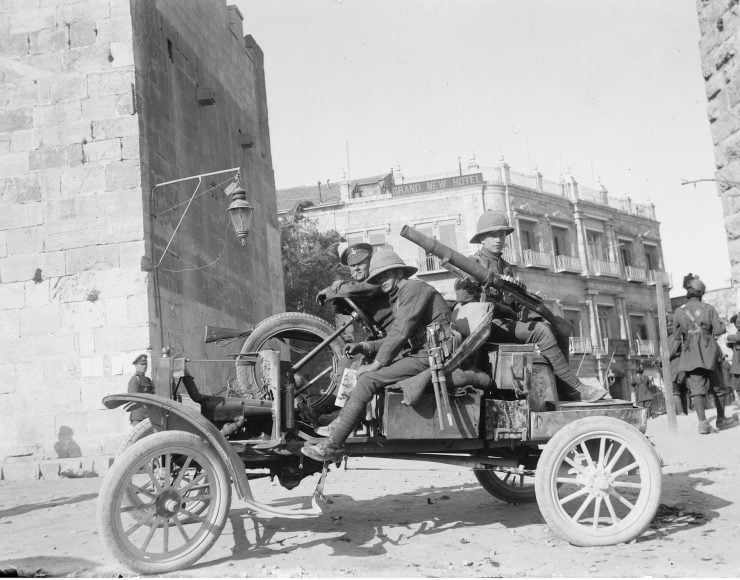
Although the Great War had begun in 1914 it was not until 1917 that the United States entered the war. Henry Ford had been a prominent supporter of the “Keep America Out of the War” movement but once the United States was committed to entering the fight he realized he would need to supply what his nation demanded. 390,000 Model T’s were made and sold to the US Army, of which 15,000 saw service with the American Expeditionary Force (A.E.F.) in the war in Europe, and without doubt they served to help secure its speedy end.
Generally speaking the Ford Model T served remarkably well during the Great War and was generally much appreciated by those who manned them, and those who were rescued by them. One would be soldier-poet penned this tongue-in-cheek piece based on Psalm 23:
The Ford is my car;
I shall not want another.
It maketh me to lie down in wet places;
It soileth my soul;
It leadeth me into deep waters;
It leadeth me into paths of ridicule for its namesake;
It prepareth a breakdown for me in the presence of mine enemies.
Yea, though I run through the valleys, I am towed up the hill;
I fear great evil when it is with me.
Its rods and its engines discomfort me;
It annointeth my face with oil;
Its tank runneth over.
Surely to goodness if this thing follow me all the days of my life,
I shall dwell in the house of the insane forever.
Born Again: As a Hot Rod
Production of the Ford Model T ended in 1927 and it was superseded by the Ford Model A. Henry Ford told people he wanted to start all over again with the letter designations for models so Model A it was to be. This left a vast inventory of Tin Lizzy’s all over the world which were progressively retired and finished up gathering rust in yards and barns. It was during the 1950’s that the abandoned Model T’s were unexpectedly given a new lease on life.
The first “T-bucket” hot rod was created by Norm Grabowski back in the early 1950’s. Although hot rods were already a popular thing Grabowski is credited with building the first T-bucket using parts from a Model A and Model T with some extensive modifications. The engine he used was a V8 out of his parent’s Cadillac: legend has it that he persuaded his parents that their Caddy needed a new engine, and he then ensured that the “worn out” engine didn’t go to waste.
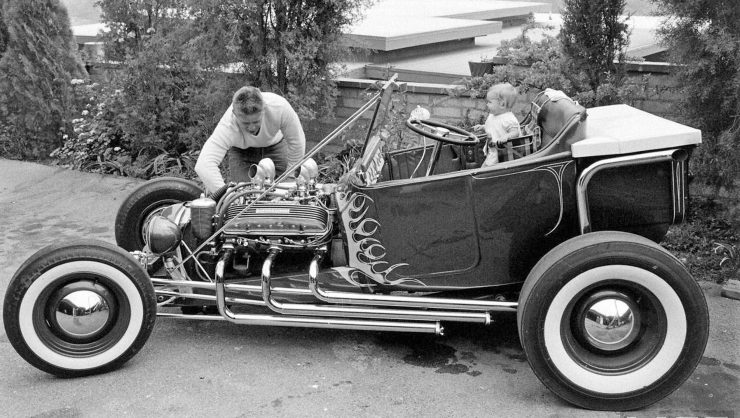
Norm Grabowski’s modifications to the hot rod included a flipped rear spring, suicide front axle combined with six inch spacers at the rear to give the car a rakish stance. His car was finished in blue with flames along the sides and instantly created a style that was widely imitated, and that appeared in various movies, most notably driven by “Kookie” in “77 Sunset Strip”, until it was wrecked by an actor on a movie set. After than Norm did his own stunt driving for his cars in movies.
So the Model T didn’t die, it just got a whole lot faster: and it proved itself on the drag strips. It even got brakes at the rear and the front: some even had parachutes to lose some velocity at the end of the quarter mile.
Conclusion
Production of the Ford Model T ended on May 26th, 1927. Henry Ford and his son Edsel ceremoniously drove the last Model T out of the factory and into the history books. At that point no less than fifteen million Model Ts had been produced, a number likely to have been much larger than even Henry Ford might have anticipated back in 1908 when they were turning out eleven cars per month.
The Model T was a pioneering automobile. It was a pioneer of mass production, and a pioneer of providing automobiles that ordinary people could afford. Above all others this was the car that brought about the automotive revolution not only in the United States and Canada, but world wide.
Not only that but it also served its country in wartime and saved many lives, especially in its role as an ambulance. The Ford Model T earned its place as an American icon, without doubt it is the most significant automobile of the twentieth century.
https://youtu.be/gHwqTZFnjoY
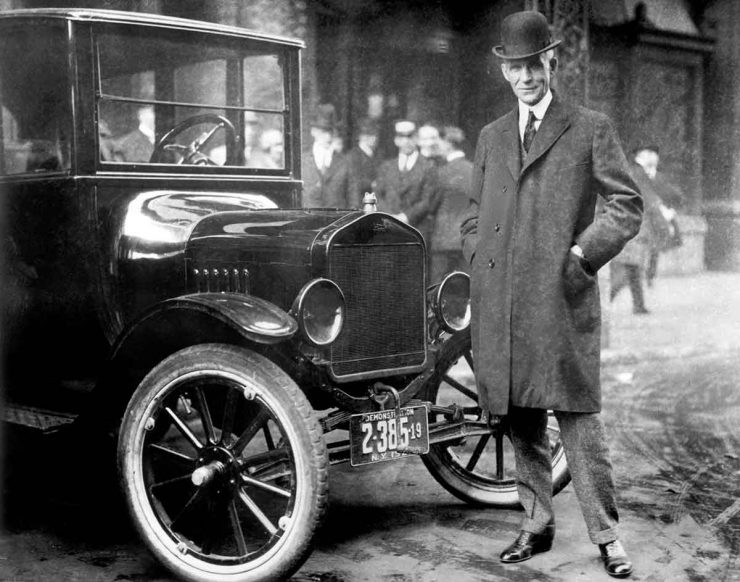
Photo Credits: Ford Motor Company, Library of Congress, RM Sotheby’s, Pullford.

